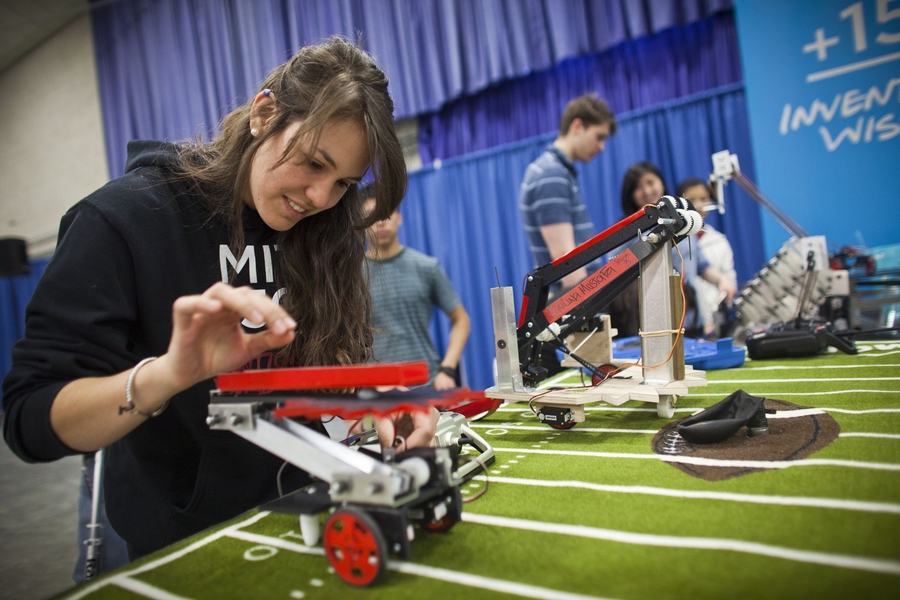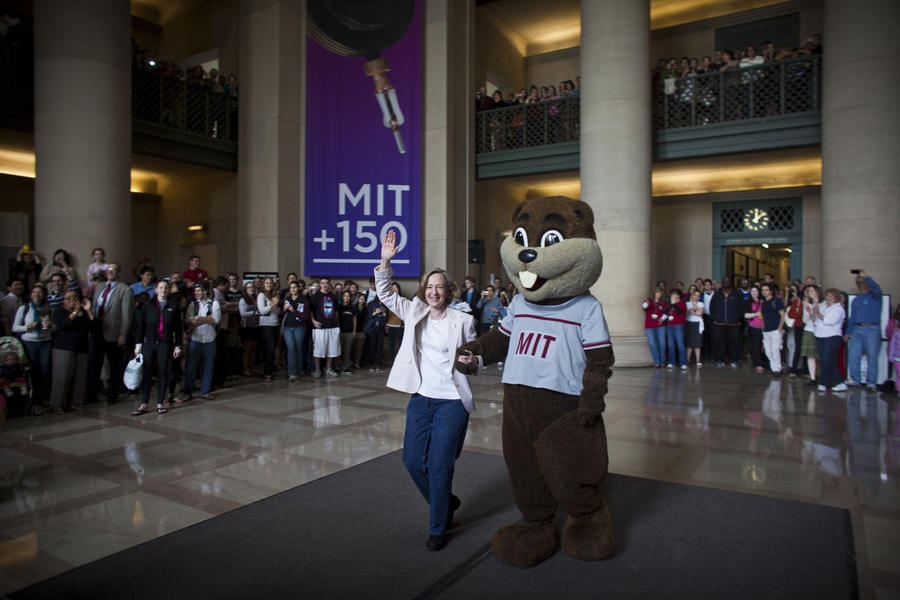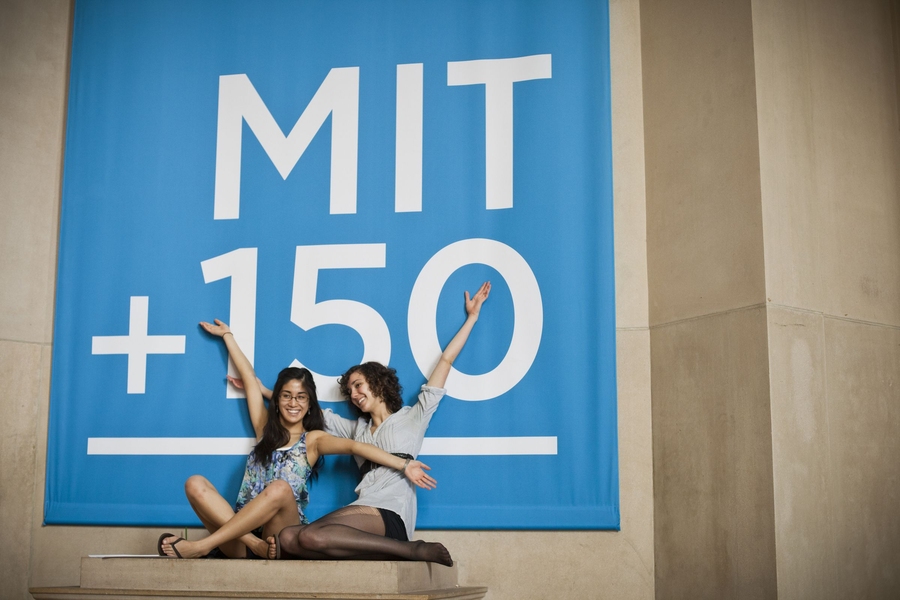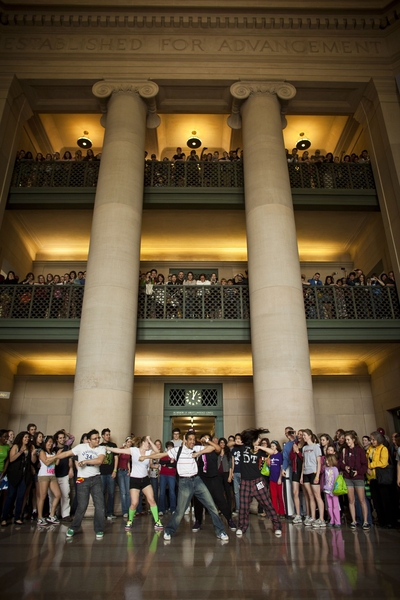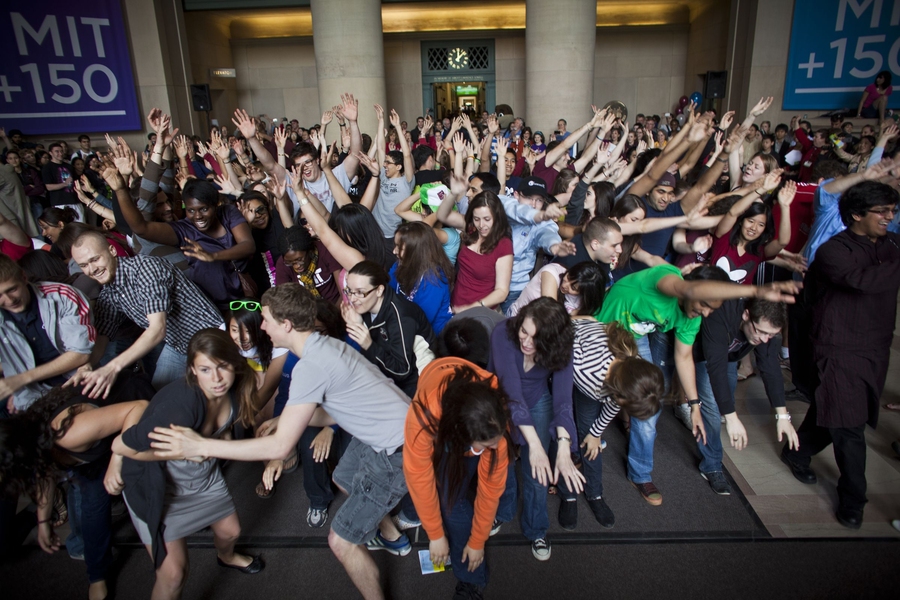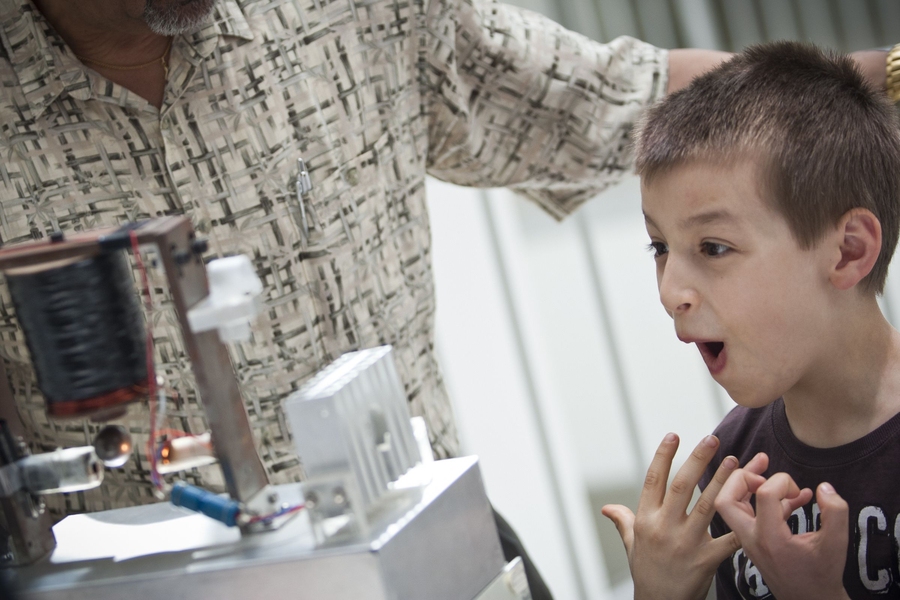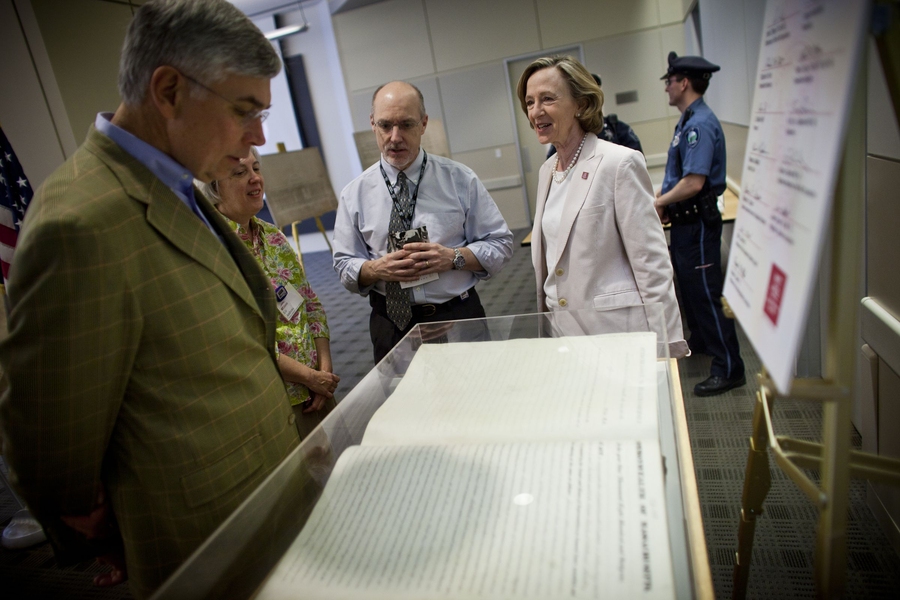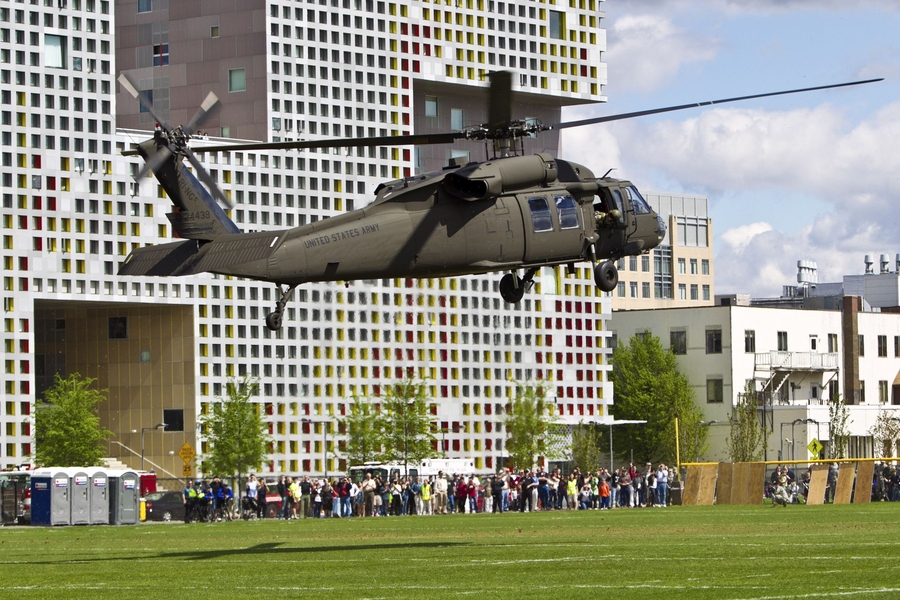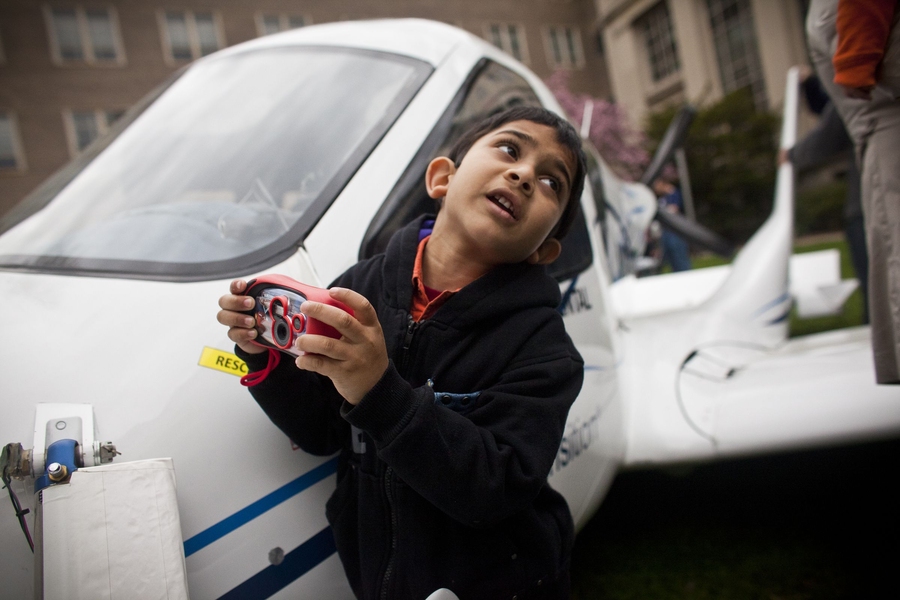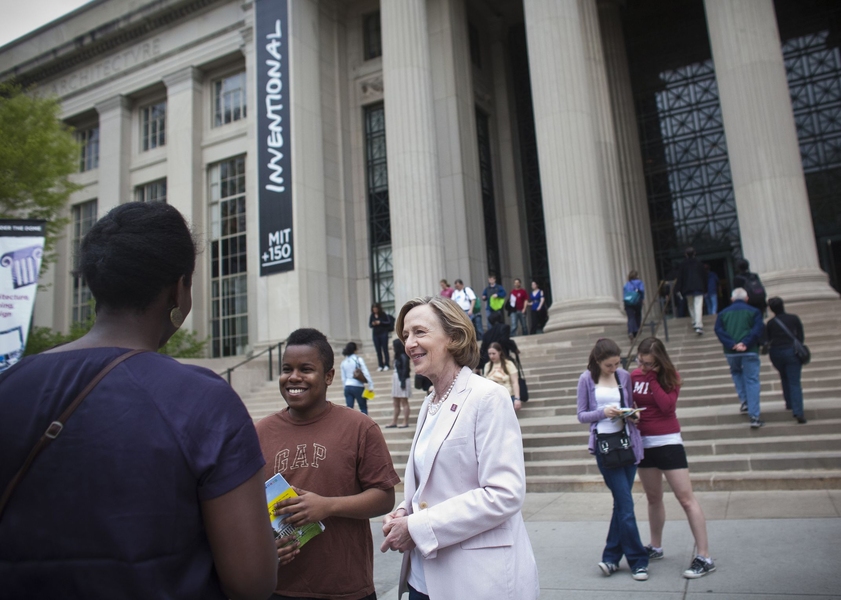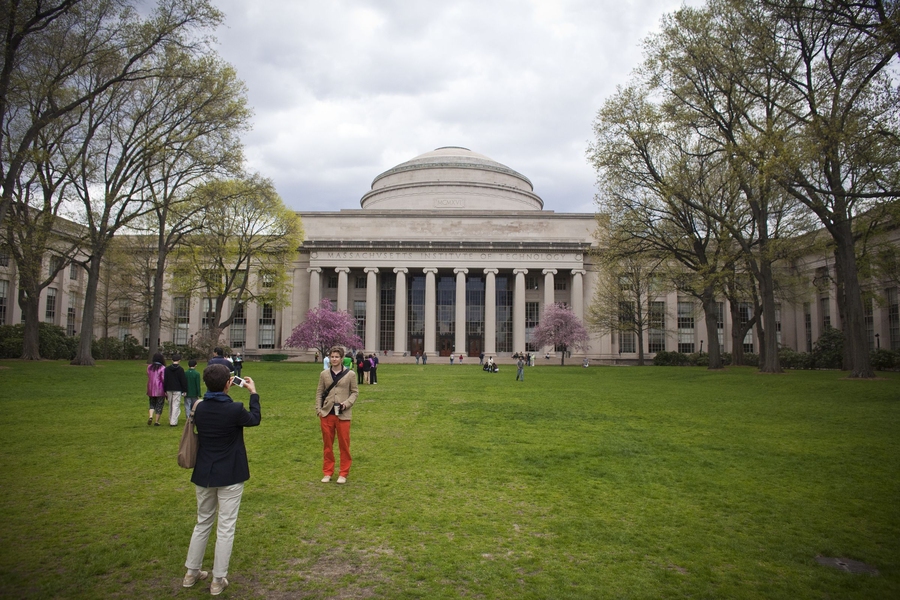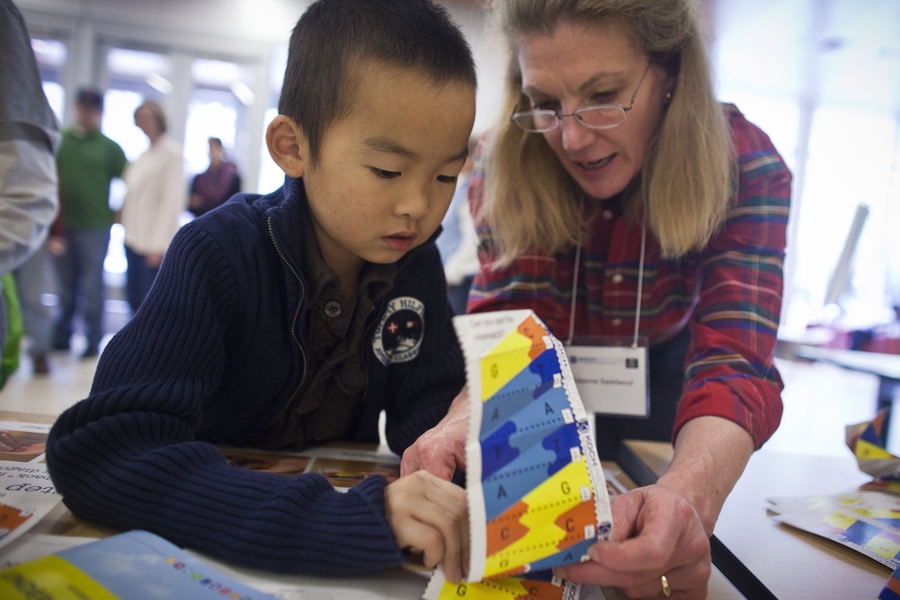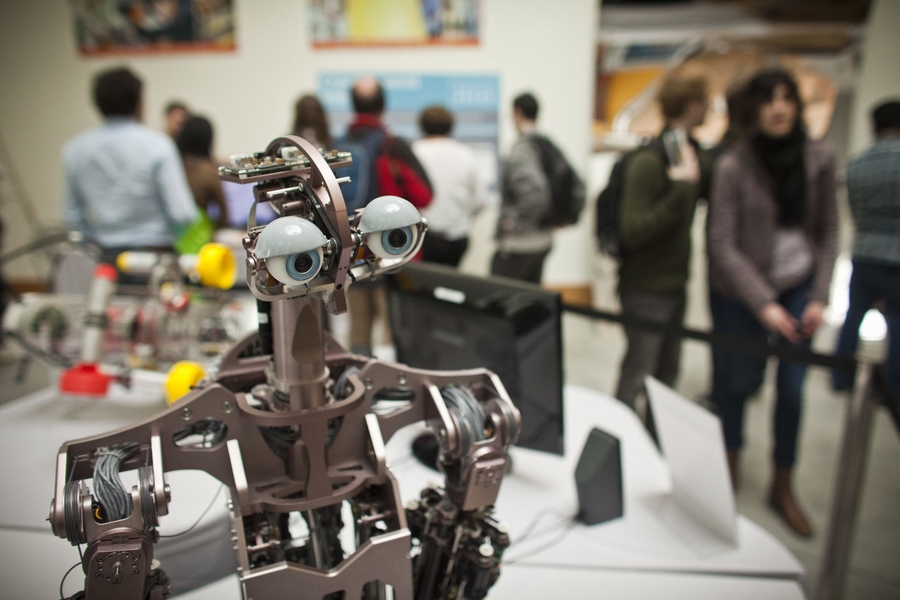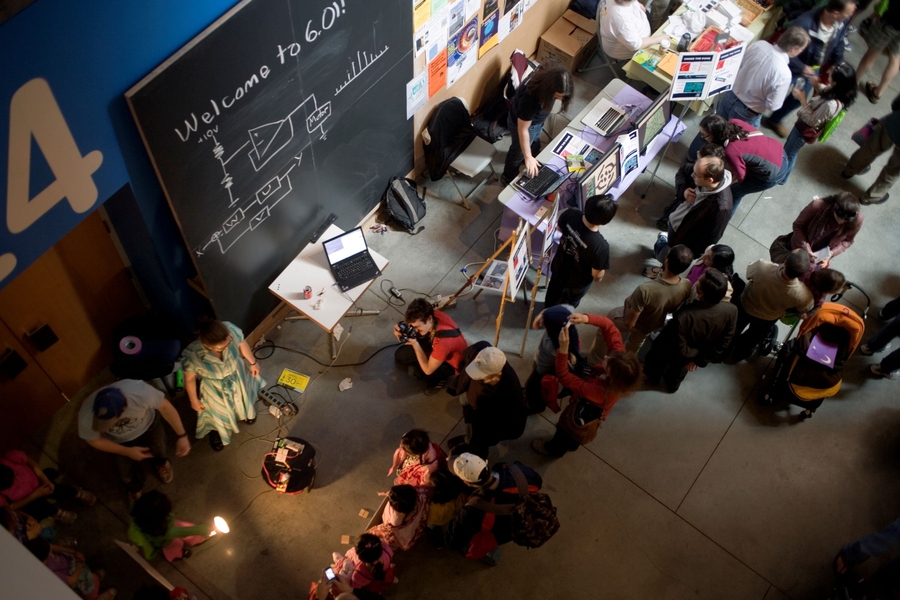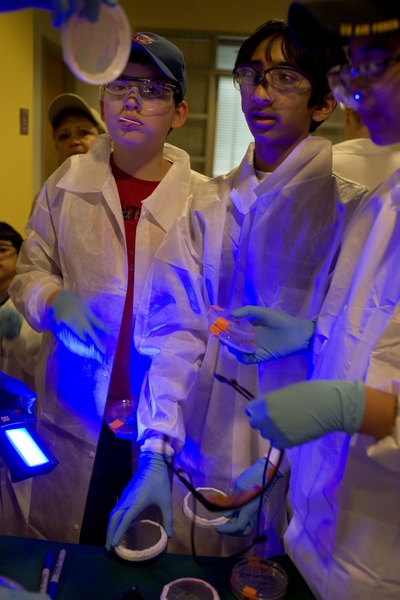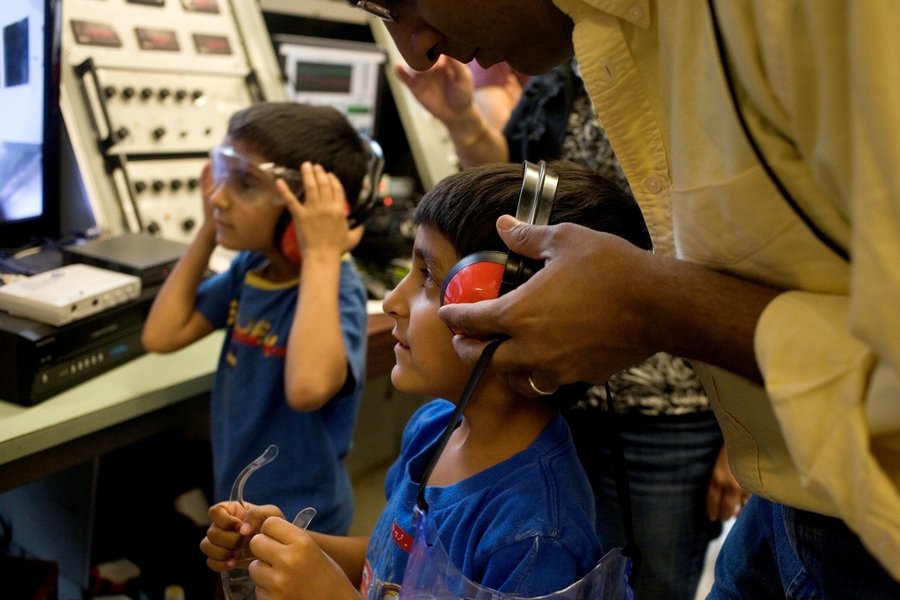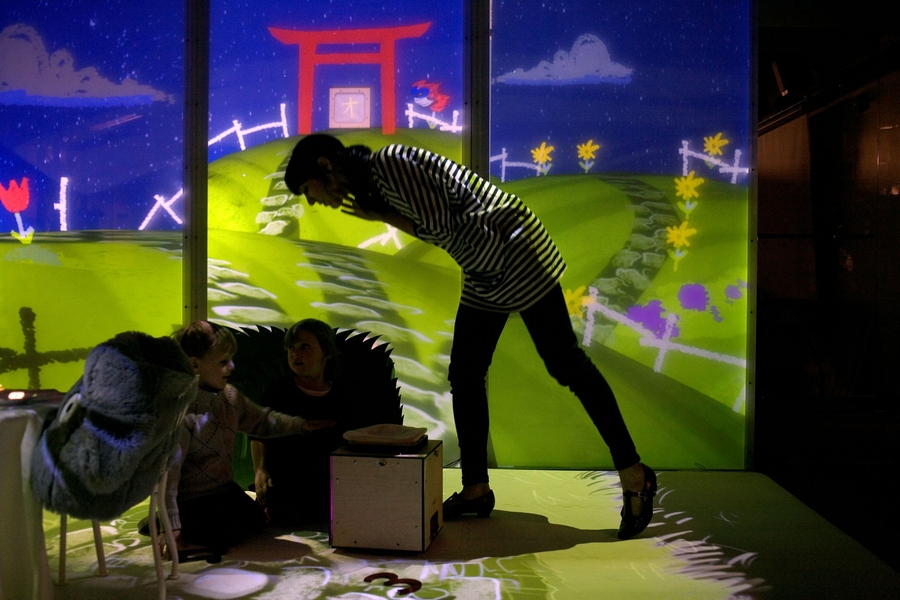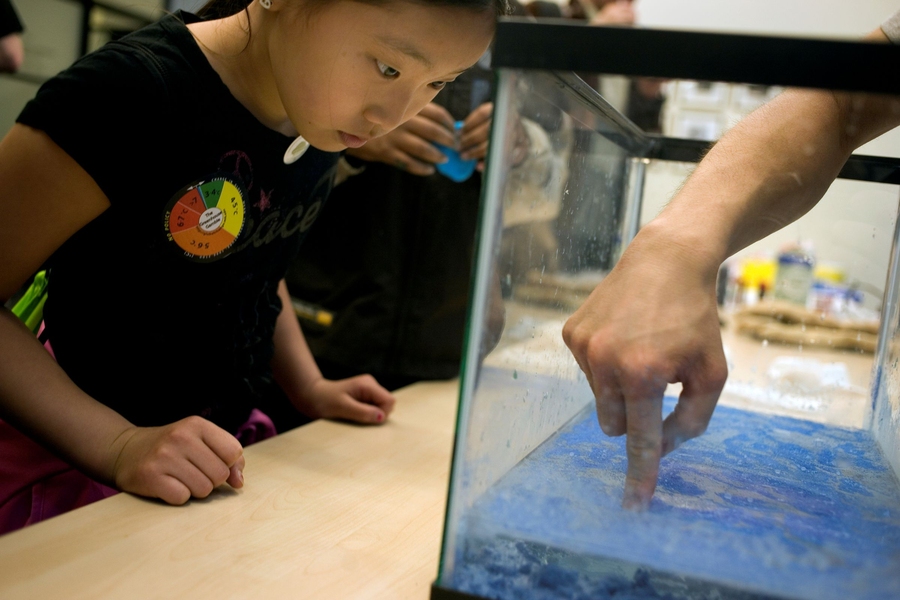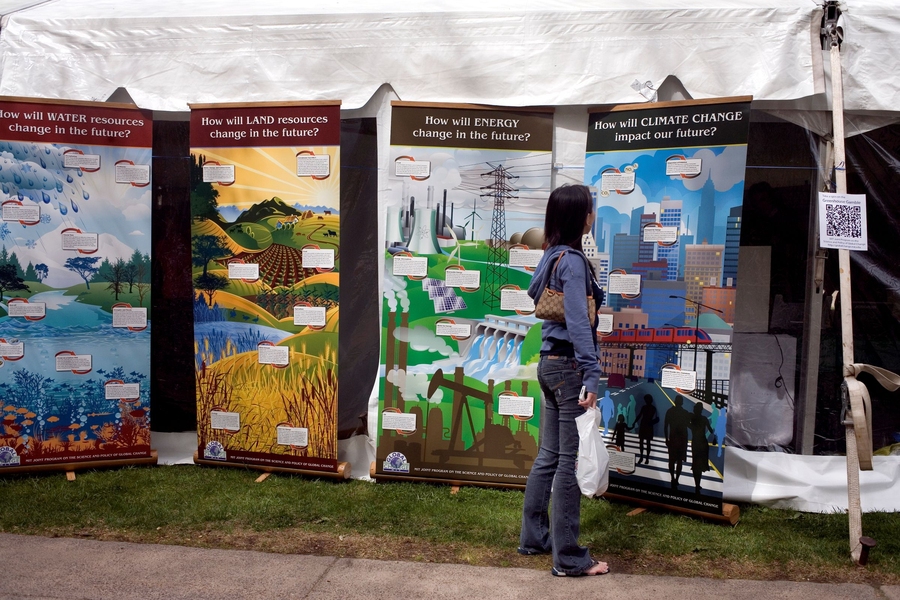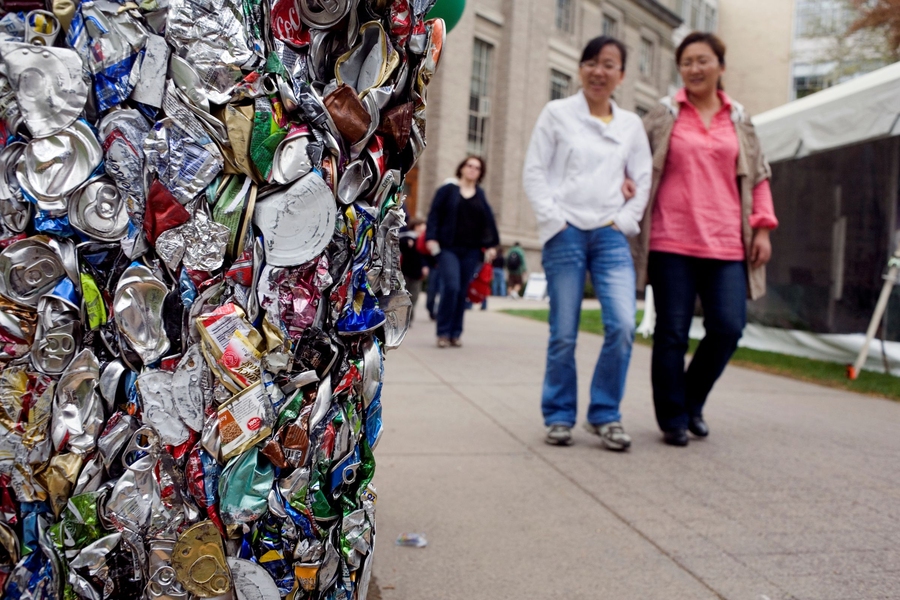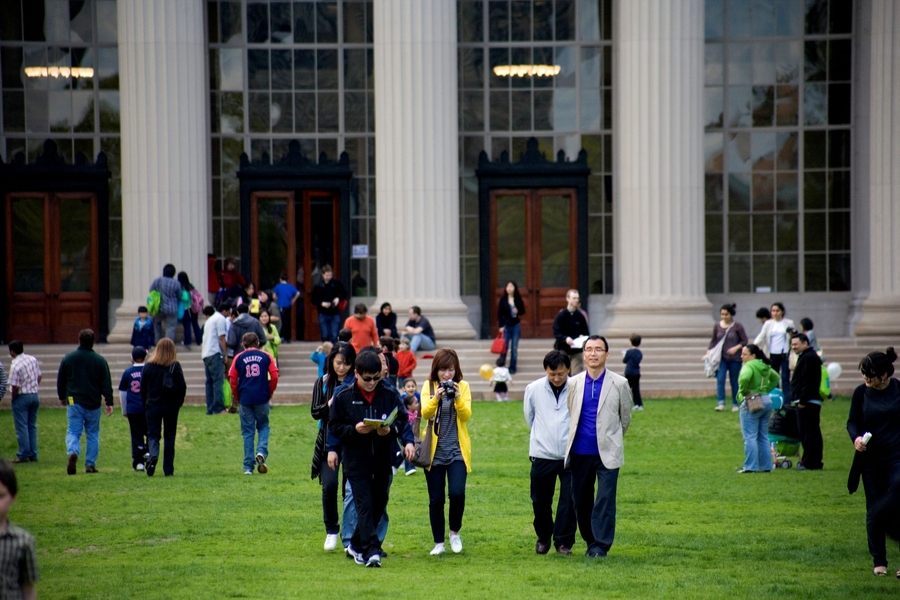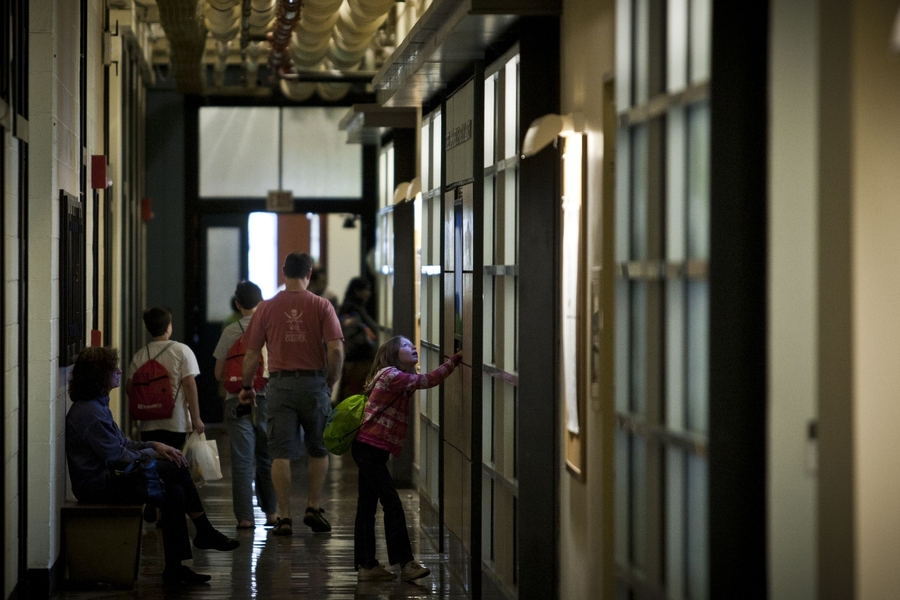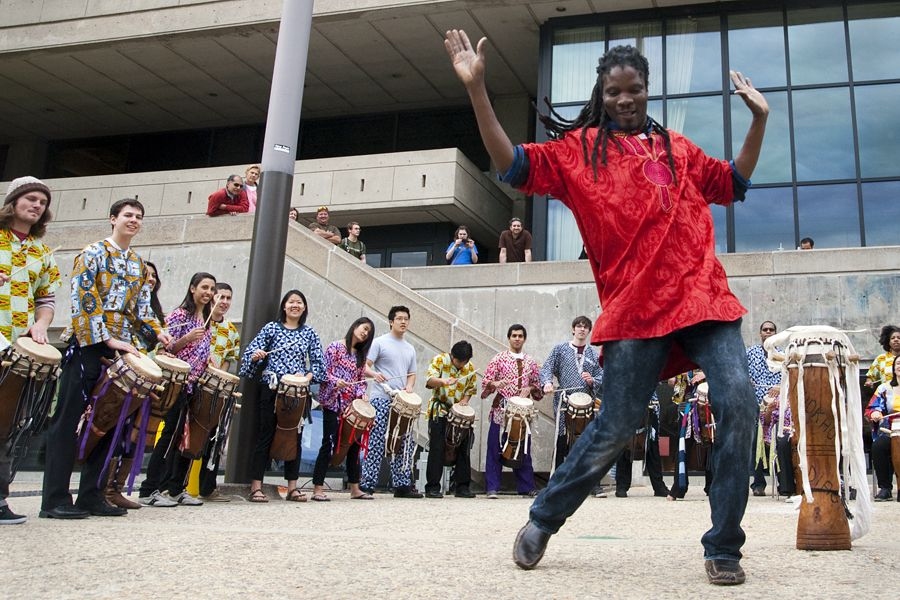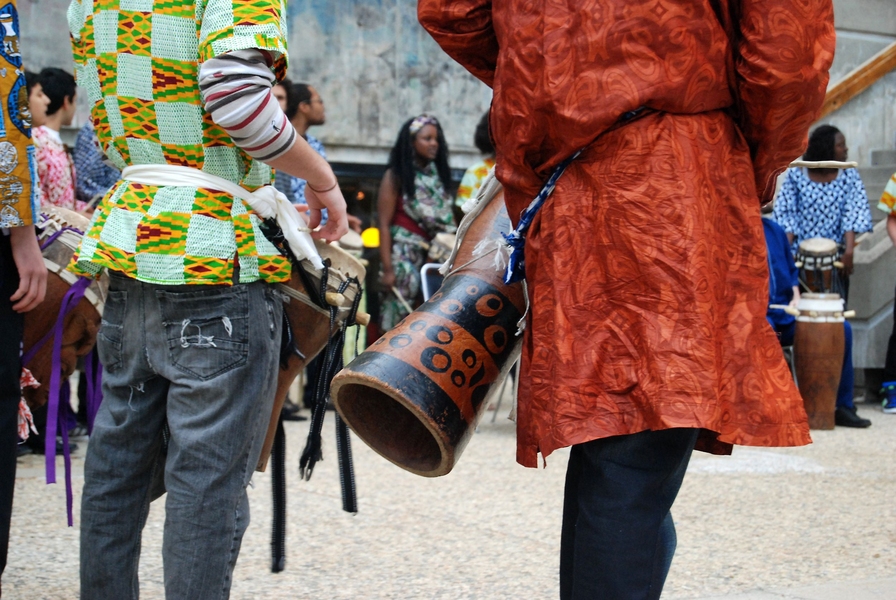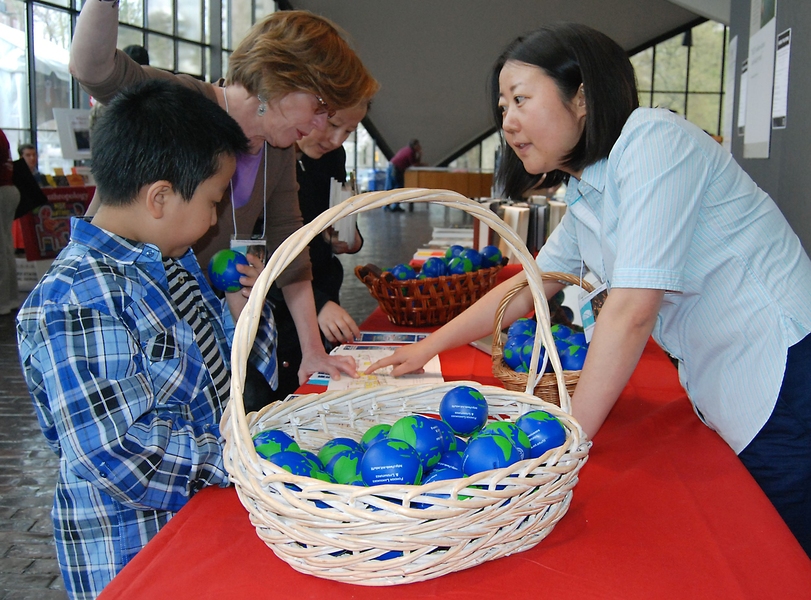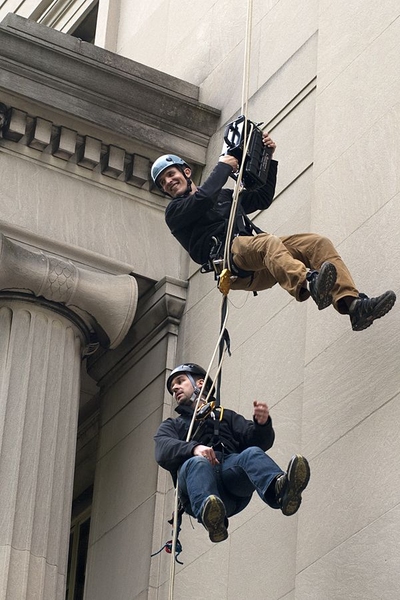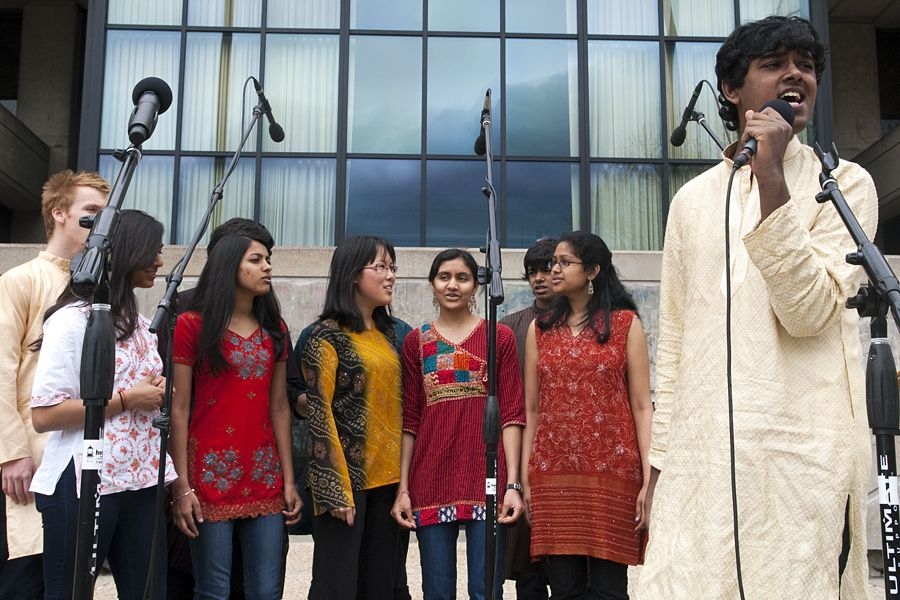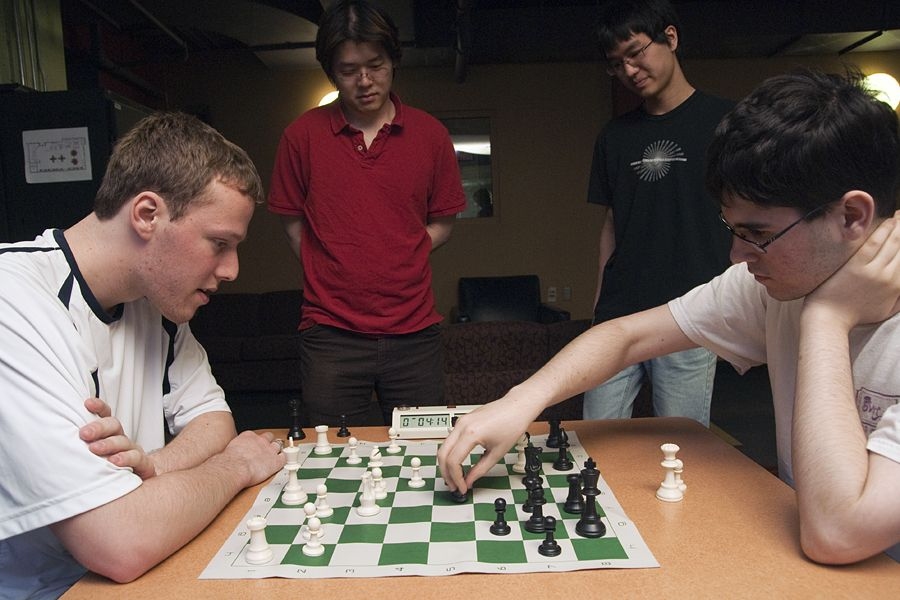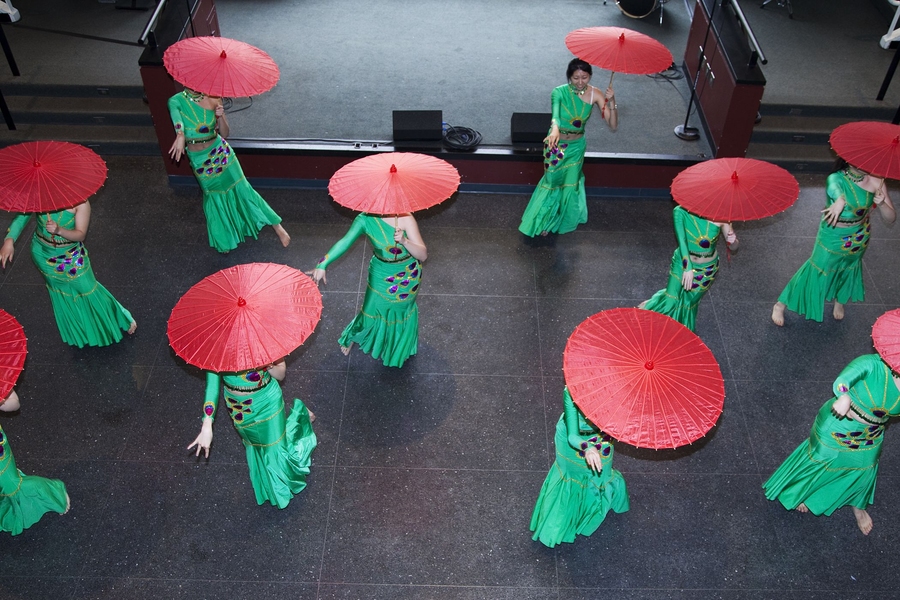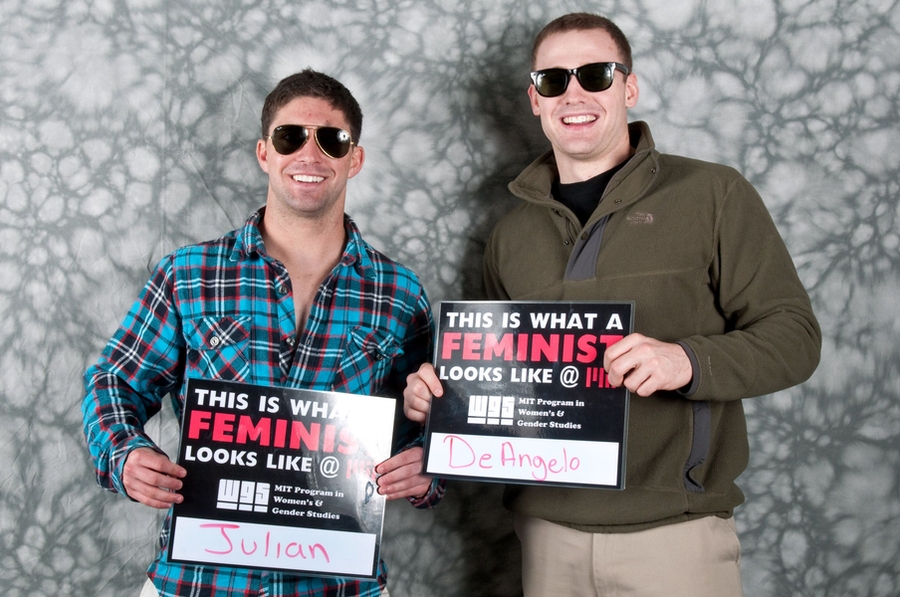Approximately 20,000 people descended on campus Saturday for “Under the Dome,” MIT's first open house in more than 30 years, where visitors of all ages got an up-close and often hands-on view of MIT’s cutting-edge work.
During the 11 a.m. to 4 p.m. event, virtually every segment of the Institute, from cancer research to aeronautics to the performing arts, opened its doors with demonstrations, lectures and activities to engage the community. Of the makeup of the diverse crowd, MIT President Susan Hockfield said, “We’ve seen lots of families and lots of young people. Some of them are MIT students-to-be — I hope today holds enough interest and excitement to fuel your passion for the kind of things we do here.”
Dan Coleman of Mobile, Ala., who came to MIT with his 16-year-old son, was impressed by the accessibility of the event. “People have this idea that stuff at MIT is all over their heads, but [this event] brings it down to a level much closer to what they see every day,” he said.
Look up, look down, look all around
At precisely 11 a.m., twin Black Hawk helicopters flew over the Charles River, circled Simmons Hall and touched down in Briggs Field, kicking up dust over a delighted crowd. Their pilots, from the National Guard and MIT Army ROTC, descended from the choppers to explain aspects of the Black Hawks’ design and function and pose for photos.
But the helicopters were just the beginning for flight enthusiasts. Many of the day’s events had visitors looking up — while piloting a basketball-sized SPHERES satellite in the Space Systems Lab, or observing the trajectories of model airplanes they had built with their own hands. There were demonstrations of how aircraft can be flown using everything from computers to robots to iPhones.
While some craned their necks skyward, others bent over magnifiers, peering through lenses to examine carbon nanotubes or biology’s tiny “water bear” organisms. “They really do look like bears,” said 11-year-old Andrea Burke of Cambridge, raising her eyebrows as she peered through a microscope.
“There’s been a lot of interest; it’s great to see people from all different backgrounds and ages come out and actually ask really smart questions,” said Andrew Kopeikin, a graduate student in aeronautics and astronautics, who was running a station where visitors could fly unmanned aerial vehicles.
Meg Krench, a graduate student in brain and cognitive sciences, echoed Kopeikin’s sentiments as she held one end of a rope demonstration designed to simulate the actions of neurons. “I’ve been fascinated by the number of kids that have come by that have been so well versed in neuroscience,” she said.
Robots, glass art and contests — oh my!
Many of the day’s activities carried a competitive component. A blimp contest, hosted by former astronaut Jeff Hoffman, Professor of the Practice in Department of Aeronautics and Astronautics, featured several heats of student-built remote-controlled blimps racing around a track set up in the Johnson Athletics Center. “[The team] ‘Nerdy Blimp Domination’ had a pretty awesome finish,” according to 8-year-old Elias Hyde of Cambridge.
Hockfield herself announced the winner of the blimp competition when she took the stage at 1 p.m. in Johnson to deliver a welcome speech.
“I want to thank you all for being right here, right now, because I know there are about 2,000 other things you could be doing all around campus,” she said, before ceding the stage to the Department of Mechanical Engineering’s much-anticipated 2.007 robot competition.
Robots were indeed a theme throughout the day. There were robots made from LEGOs, robots that could chase a moving light, and robots that could scuttle up the sides of buildings. The ground floor of the Stata Center played host to a vast array of engineering demonstrations that captivated young and old alike.
When asked what her favorite activity was, Daniela Ronga, an 11-year-old from Pelham, N.H., was deciding between robots that could pick up tennis balls, a rope-system rescue demonstration ascending the wall of Building 3, and glass blowing.
"I don’t know. There’s been a lot of cool things here,” she said with a smile.
Sharing the stage
Even amid a heavy science focus, MIT arts claimed a slice of the spotlight, as student music groups regaled visitors with a steady stream of performances outside the Stratton Student Center, as well as inside Kresge Auditorium and a nearby tent.
“I came for the science, but I guess I didn’t realize how much arts there are here,” said Amanda Garcia, a 14-year-old from Bedford, Mass., over the sounds of a nearby bagpipe.
Some activities even bridged art and science, like a math-inspired origami project that showed visitors how to create infinitely interlocking Sonobe units, or a Media Lab demonstration that had guests making music with pencils. Art installations across campus that were part of the MIT150 Festival of Art + Science + Technology (FAST) attracted plenty of attention, with guests pausing to smile and frown at the MIT Mood Meters — camera software that can detect facial expressions — installed in high-traffic corridors.
The entrepreneurial spirit also had a strong showing, with a startup showcase at the MIT Sloan School of Management and a lecture by Nobel Prize-winning economist Peter Diamond. “It’s great to show people what we do. I don’t know if this is more fun for them or for us!” said linguistics graduate student Kirill Shklovsky, who was luring participants with the promise of Mexican chocolate if they could solve puzzles in a rare Mayan language.
Delighting the senses
Meanwhile, tucked away in the northwest corner of campus, audience members donned “holographic diffraction glasses” as plasma scientists turned off the lights to reveal the distinct rainbow patterns — due to differing energy levels — produced by incandescent bulbs, compact fluorescent lamps and pure mercury. The demonstration even made use of everyday substances such as nail polish and pickles to light the room.
Across Massachusetts Avenue, visitors donned headphones — to block out the 120-decibel sound levels — and entered MIT’s Wright Brothers Wind Tunnel, where hair and loose clothing flapped wildly as they were subjected to winds that, according to 8-year-old Christian Gray of Cambridge, “felt much stronger than 30 miles per hour.”
At least one activity was not on the event’s official schedule. At noon, visitors in and around Lobby 7 were treated to a flash mob performance that began with five dancers and grew to a crowd of more than 100 MIT students, faculty and staff dancing in choreographed unison. Once the group reached a critical mass, it spilled out across Massachusetts Avenue, where police stopped traffic and more members of the MIT community — including some senior administrators — joined the dancers as they made their way across the street, many of them waving various nations’ flags above their heads. MIT mascot Tim the Beaver escorted Hockfield to the top of the steps, where she smiled and waved to the crowd.
“So, what do you think: Should we do this more often?” Hockfield asked a few minutes later, during her welcome speech. (Saturday’s event was MIT’s first open house since 1978.) The crowd’s enthusiastic cheers gave her the answer.
A flash mob of more than 150 of MIT's community members breakin' it down in Lobby 7 at MIT's 150th anniversary open house on April 30.
Video: Skylight Studios
During the 11 a.m. to 4 p.m. event, virtually every segment of the Institute, from cancer research to aeronautics to the performing arts, opened its doors with demonstrations, lectures and activities to engage the community. Of the makeup of the diverse crowd, MIT President Susan Hockfield said, “We’ve seen lots of families and lots of young people. Some of them are MIT students-to-be — I hope today holds enough interest and excitement to fuel your passion for the kind of things we do here.”
Dan Coleman of Mobile, Ala., who came to MIT with his 16-year-old son, was impressed by the accessibility of the event. “People have this idea that stuff at MIT is all over their heads, but [this event] brings it down to a level much closer to what they see every day,” he said.
Look up, look down, look all around
At precisely 11 a.m., twin Black Hawk helicopters flew over the Charles River, circled Simmons Hall and touched down in Briggs Field, kicking up dust over a delighted crowd. Their pilots, from the National Guard and MIT Army ROTC, descended from the choppers to explain aspects of the Black Hawks’ design and function and pose for photos.
But the helicopters were just the beginning for flight enthusiasts. Many of the day’s events had visitors looking up — while piloting a basketball-sized SPHERES satellite in the Space Systems Lab, or observing the trajectories of model airplanes they had built with their own hands. There were demonstrations of how aircraft can be flown using everything from computers to robots to iPhones.
While some craned their necks skyward, others bent over magnifiers, peering through lenses to examine carbon nanotubes or biology’s tiny “water bear” organisms. “They really do look like bears,” said 11-year-old Andrea Burke of Cambridge, raising her eyebrows as she peered through a microscope.
“There’s been a lot of interest; it’s great to see people from all different backgrounds and ages come out and actually ask really smart questions,” said Andrew Kopeikin, a graduate student in aeronautics and astronautics, who was running a station where visitors could fly unmanned aerial vehicles.
Meg Krench, a graduate student in brain and cognitive sciences, echoed Kopeikin’s sentiments as she held one end of a rope demonstration designed to simulate the actions of neurons. “I’ve been fascinated by the number of kids that have come by that have been so well versed in neuroscience,” she said.
Robots, glass art and contests — oh my!
Many of the day’s activities carried a competitive component. A blimp contest, hosted by former astronaut Jeff Hoffman, Professor of the Practice in Department of Aeronautics and Astronautics, featured several heats of student-built remote-controlled blimps racing around a track set up in the Johnson Athletics Center. “[The team] ‘Nerdy Blimp Domination’ had a pretty awesome finish,” according to 8-year-old Elias Hyde of Cambridge.
Hockfield herself announced the winner of the blimp competition when she took the stage at 1 p.m. in Johnson to deliver a welcome speech.
“I want to thank you all for being right here, right now, because I know there are about 2,000 other things you could be doing all around campus,” she said, before ceding the stage to the Department of Mechanical Engineering’s much-anticipated 2.007 robot competition.
Robots were indeed a theme throughout the day. There were robots made from LEGOs, robots that could chase a moving light, and robots that could scuttle up the sides of buildings. The ground floor of the Stata Center played host to a vast array of engineering demonstrations that captivated young and old alike.
When asked what her favorite activity was, Daniela Ronga, an 11-year-old from Pelham, N.H., was deciding between robots that could pick up tennis balls, a rope-system rescue demonstration ascending the wall of Building 3, and glass blowing.
"I don’t know. There’s been a lot of cool things here,” she said with a smile.
Sharing the stage
Even amid a heavy science focus, MIT arts claimed a slice of the spotlight, as student music groups regaled visitors with a steady stream of performances outside the Stratton Student Center, as well as inside Kresge Auditorium and a nearby tent.
“I came for the science, but I guess I didn’t realize how much arts there are here,” said Amanda Garcia, a 14-year-old from Bedford, Mass., over the sounds of a nearby bagpipe.
Some activities even bridged art and science, like a math-inspired origami project that showed visitors how to create infinitely interlocking Sonobe units, or a Media Lab demonstration that had guests making music with pencils. Art installations across campus that were part of the MIT150 Festival of Art + Science + Technology (FAST) attracted plenty of attention, with guests pausing to smile and frown at the MIT Mood Meters — camera software that can detect facial expressions — installed in high-traffic corridors.
The entrepreneurial spirit also had a strong showing, with a startup showcase at the MIT Sloan School of Management and a lecture by Nobel Prize-winning economist Peter Diamond. “It’s great to show people what we do. I don’t know if this is more fun for them or for us!” said linguistics graduate student Kirill Shklovsky, who was luring participants with the promise of Mexican chocolate if they could solve puzzles in a rare Mayan language.
Delighting the senses
Meanwhile, tucked away in the northwest corner of campus, audience members donned “holographic diffraction glasses” as plasma scientists turned off the lights to reveal the distinct rainbow patterns — due to differing energy levels — produced by incandescent bulbs, compact fluorescent lamps and pure mercury. The demonstration even made use of everyday substances such as nail polish and pickles to light the room.
Across Massachusetts Avenue, visitors donned headphones — to block out the 120-decibel sound levels — and entered MIT’s Wright Brothers Wind Tunnel, where hair and loose clothing flapped wildly as they were subjected to winds that, according to 8-year-old Christian Gray of Cambridge, “felt much stronger than 30 miles per hour.”
At least one activity was not on the event’s official schedule. At noon, visitors in and around Lobby 7 were treated to a flash mob performance that began with five dancers and grew to a crowd of more than 100 MIT students, faculty and staff dancing in choreographed unison. Once the group reached a critical mass, it spilled out across Massachusetts Avenue, where police stopped traffic and more members of the MIT community — including some senior administrators — joined the dancers as they made their way across the street, many of them waving various nations’ flags above their heads. MIT mascot Tim the Beaver escorted Hockfield to the top of the steps, where she smiled and waved to the crowd.
“So, what do you think: Should we do this more often?” Hockfield asked a few minutes later, during her welcome speech. (Saturday’s event was MIT’s first open house since 1978.) The crowd’s enthusiastic cheers gave her the answer.
A flash mob of more than 150 of MIT's community members breakin' it down in Lobby 7 at MIT's 150th anniversary open house on April 30.
Video: Skylight Studios
